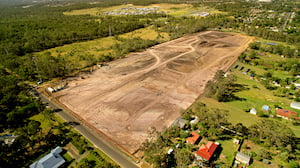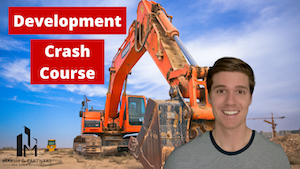CRE Development Mistakes - Real Estate Site Selection
Site selection isn't the mysterious boogeyman that it's sometimes made out to be. But finding the wrong site, or failing to address several major items during the site selection process, often leads to project failure.
Every successful real estate development project begins with the right site - not necessarily the perfect site or the best site - but a piece of land that you've thoroughly investigated and which meets your goals.
Check out the video below to learn more about common mistakes made during the real estate development site selection process.
Guide to the video
- Site selection is a critical phase of the real estate development process
- Important due diligence items are often overlooked during site selection
- There are ways to avoid expensive and time-consuming real estate site selection mistakes
Video transcript follows
A piece of raw land represents the apex of untapped potential. The height of being able to leave your mark on the world for future generations. And that’s why we’re so passionate about it. But missteps along the way to finding the right location for your project costs money, can derail developments and can even stunt business growth.
Hey everyone – it’s Matt Marsh with Marsh & Partners.
Marsh & Partners is a development and national consulting firm that helps business owners and investors maximize their real estate and transform their businesses.
----------
In this video, we are going to talk about real estate development site selection. But what goes in to finding the right site? And what avoidable mistakes most commonly force developers to abandon projects early? We’ll discuss all that and more in the latest addition to our video series - CRE development mistakes.
We’ve written on the site selection process before. If you want a deep dive, there is a link in the video description, and you can visit our blog to learn more. So, we aren’t going to cover all that here, but let’s first start with a quick level set.
Real estate development site selection is the actual process of finding a site and picking a plot of land to pursue a development project.
Not all vacant land is created equal. Properties are subject to various influences that impact the viability of a site. External factors like zoning restrictions, demographic trends, municipal ordinances, and the path of growth need to be considered.
Conversely, site-specific factors like environmental considerations, necessary site work, utilities, and a property’s highest and best use should also be weighed.
It’s undoubtedly a lot to consider and it means that some land may be better suited for specific projects than others. Farmland probably commands a different use than an urban infill site, for instance.
And since there is a lot to consider, there’re opportunities for mistakes along the way. I’ve made my fair share of them. And they’ve cost me. But those failure as both a developer and real estate consultant have helped shape my understanding of the process.
So, I wanted to distill some of those lessons learned during site selection miscues to help you avoid them during your projects.
Becoming a prisoner of the moment
The first common mistake that almost invariably leads to project failure is allowing yourself to become a prisoner of the moment.
At some point in our lives, we’ve all gotten wrapped up into the latest fad or trend. Maybe you made an impulse purchase or subscribed to a diet because your favorite podcaster said you should. And if you’re shaking your head as I say that, you’re either much stronger-willed than I, or you’re lying to yourself.
But the same goes for real estate. Developers get swept up into building trends all the time – and it happens for a variety of reasons. They could be chasing dollars or maybe it’s just the path of least resistance.
Decades ago, it was single-family home building craze. Then developers raced to build suburban office space to accommodate the increased number of rooftops. In the 90’s and 2000’s mixed use development saw a resurgence as an answer to increased urban sprawl. Now there’s a huge focus on industrial and life science development, office conversions, and single-family build-to-rent projects.
Now, if you’ve pursued those opportunities, was it mistake? Not necessarily – especially if the underlying demand was justifiable and you made some money doing it.
But too often, developers fail to consider whether market conditions and short-term opportunities are actually long-term trends. What demand drivers are motivating developers to supply a certain product and are they sustainable?
We even have a recent example to point to as a result of COVID. Work from home mandates forced offices to go vacant for 2020 and a better part of 2021.
Many experts surmised that a vaccine would signal a return to normalcy and office and hospitality real estate would experience a “V” shaped recovery. But as 2021 continued, it was clear that the remote trend was in large part, here to say.
One could argue that COVID was simply a short-term shock to a well-functioning business model. But if you look closely, the writing was on the wall even as early as 2018 and 2019. Employers were already shifting more work remote with the availability of remote work tools.
Covid was merely a catalyst that accelerated what was already a major long-term market shift.
Failure to weigh opportunity costs
Another common mistake made during the site selection process is the failure to weigh opportunity costs.
This all begins with real estate strategy. Let’s pretend you’re a small business that’s outgrown your 10K sf building. After a careful lease vs. buy vs. build analysis, you’ve determined that building a new location is the right answer. So, the next step is to go out and find the right site for your business.
Most business owners start for looking for a site that can accommodate their space needs. If you’ve outgrown 10K sf, maybe you look for a site that allows you to build 15-20K sf.
But that binary approach to site selection often leads many questions unanswered.
How important is location to your business? How does location impact your ability to retain and hire new talent? Should you build a larger building, lease a portion of it out and become a landlord? What are your business’s long-term growth prospects – should you find a site that allows for future expansion?
And how do all these variables impact the project?
Every location offers distinct strengths, weaknesses, and opportunities – you need to weigh your unique criteria to assess their importance to project success.
There will be opportunity costs that stem from these decisions. But if you’ve racked and stacked your needs properly, you can account for, and mitigate downside risks.
Inadequate site due diligence
Inadequate site due diligence is another mistake developers make during site selection.
Site due diligence is more than just the obligatory title work and environmental study. Thorough due diligence allows you identify site issues before you’ve committed large amounts of money to a project.
As a developer, you’ll want to assess things like:
- Topography and water features or wetlands
- Access to utilities
- Environmental risks
- Land entitlement requirements
- Zoning and design requirements
- Off-site improvements
- Municipal ordinances
- Potential tax and development incentives
This isn’t an exhaustive list, but it’s a place to start.
If you’re interested, drop us a line and ask us about our comprehensive site due diligence checklist to help you on your next project.
If you fail to address important site issues early you might be saddled with increased development costs, an improper valuation of the property for acquisition, or even roadblocks that could kill a project.
Lack of flexibility
The last mistake I commonly see made is a lack of flexibility. I often describe the real estate development process as a marathon. It’s an exercise in patience, resilience, and your ability to creatively circumvent the challenges you’ll inevitably face during a project.
But many developers take a one size fits all attitude to development. They approach a project with an “ideal” site in mind and refuse to deviate from the strict parameters they’ve imposed on themselves.
But what works in one municipality might not work in another. What works in one submarket might not work in another. And if you’re not flexible and haven’t mentally prepared yourself for setbacks or bad news, you’ll only grow frustrated and discouraged as the site selection process progresses.
I often say that the perfect site doesn’t exist. In many markets, if a piece of land is available for sale or a property remains undeveloped, there’s likely some hair on the deal.
The developers who remain agile and have the ability to pivot upon bad news are often more successful than their rigid counterparts.
So what’s the key to avoiding these mistakes?
Ultimately a project might look good on paper, but an inadequate site can set a project up for failure. Variables change between projects it’s important to consider the site selection miscues we discussed in this video.
You’ll want to find the right civil engineer and familiarize yourself with site selection and the development processes before undertaking a real estate development.
----------
Thanks for watching everyone – if you enjoyed the video hit the like button and subscribe to our channel below, follow us on Instagram at marsh partners real estate and check out our site for more real estate insights at marsh-partners.com
Feel free to leave us a comment if there are any other topics you’re interested in or would like us to cover.
Don’t forget to subscribe if you want more content like this and thanks again for watching.



